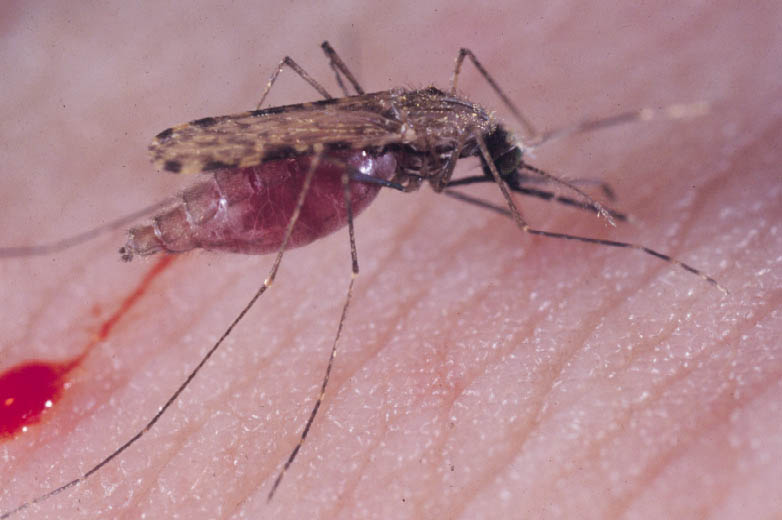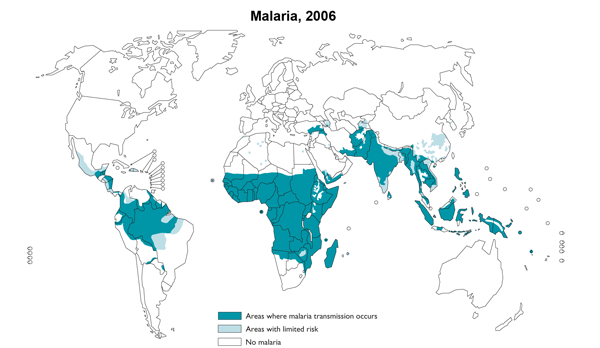Malaria
 | According to the CDC, “Malaria is a mosquito-borne disease caused by a parasite. In nature, malaria parasites spread by infecting successively two types of hosts: humans and female Anopheles mosquitoes. In humans, the parasites grow and multiply first in the liver cells and then in the red cells of the blood. In the blood, successive broods of parasites grow inside the red cells and destroy them, releasing daughter parasites that continue the cycle by invading other red cells. The blood stage parasites are those that cause the symptoms of malaria.” |
Symptoms of Malaria
|  Parasites destroying red blood cells |
Other Effects of Malaria
(According to the CDC)
· People who have developed protective immunity may be infected but not made ill by the parasites they carry
· Some persons infected with Plasmodium falciparum can develop complications such as brain disease (cerebral malaria), severe anemia, and kidney failure. These severe forms occur more frequently in people with little protective immunity, and can result in death or life-long neurologic impairment
· People subjected to frequent malaria infections (such as young children and pregnant women in high transmission areas) can develop anemia due to frequent destruction of the red blood cells by the malaria parasites. Severely anemic patients might receive blood transfusions which, in developing countries, can expose them to HIV and other bloodborne diseases
· Babies born to women who had malaria during their pregnancy are more often born with a low birth weight or prematurely, which decreases their chances of survival during early life
· In developing countries, the harmful effects of malaria may combine with those of other highly prevalent diseases and conditions, such as malnutrition, HIV/AIDS, and anemia of all causes. Such combinations can have severe results, especially if they occur repeatedly.
· Neurologic defects may occasionally persist following cerebral malaria, especially in children. Such defects include troubles with movements (ataxia), palsies, speech difficulties, deafness, and blindness.
· Recurrent infections with P. falciparum may result in severe anemia. This occurs especially in young children in tropical Africa with frequent infections that are inadequately treated.
· Malaria during pregnancy (especially P. falciparum) may cause severe disease in the mother, and may lead to premature delivery or delivery of a low-birth-weight baby.
· On rare occasions, P. vivax malaria can cause rupture of the spleen or acute respiratory distress syndrome (ARDS).
· Nephrotic syndrome (a chronic, severe kidney disease) can result from chronic or repeated infections with P. malariae.
· Hyperreactive malarial splenomegaly (also called "tropical splenomegaly syndrome") occurs infrequently and is attributed to an abnormal immune response to repeated malarial infections. The disease is marked by a very enlarged spleen and liver, abnormal immunologic findings, anemia, and a susceptibility to other infections (such as skin or respiratory infections).
Prevention of Infection and Disease Infection and disease can be decreased by preventing mosquitoes that are malaria vectors from biting humans. Ways to prevent Malaria include:
|  Malaria Vectors  |

The Effect of Global Warming on Malaria
Climate is a key factor the transmission and occurrence of malaria, as it influences the life cycle of both the mosquito and the parasite. Precipitation creates collections of water, or breeding sites, where mosquito eggs are laid and allowed to develop. The development of mosquito eggs takes between 9 and 12 days in warmer tropical areas. The transmission of malaria begins with a female mosquito, or Anopheles, becoming infected with the parasite after feeding off of an infected human and hosting the parasite as it continues its developmental cycle within the mosquito. At 77°F, the parasite’s developmental cycle take between 9 and 21 days, the time period shortening in warmer temperatures. However, if temperatures drop below 59- 68°F, depending on the type of parasite, the transmission of malaria is impeded because the developmental cycle of the parasite cannot be completed. An obvious correlation exists between temperatures and occurrences of malaria.
Due to global warming, the number of geographic areas inflicted with malaria is increasing, causing multiple malaria endemics. An increase in temperatures also results in changes in human behaviors; people may wear less protective clothing, sleep outdoors, or fail to use bed nets in hot climates. This change in behavior increases the human exposure to mosquitoes, which then increases the amount of malaria.
Where climates are hot, humid, and precipitous, malaria is usually prevalent. Because global warming attributes to the increase in warmer climates where malaria occurs, the conclusion can be made that global warming could potentially spread malaria.